Sub- and suprathreshold receptive field properties of pyramidal neurones in layers 5A and 5B of rat somatosensory barrel cortex
- PMID: 14724202
- PMCID: PMC1664944
- DOI: 10.1113/jphysiol.2003.053132
Sub- and suprathreshold receptive field properties of pyramidal neurones in layers 5A and 5B of rat somatosensory barrel cortex
Abstract
Layer 5 (L5) pyramidal neurones constitute a major sub- and intracortical output of the somatosensory cortex. This layer 5 is segregated into layers 5A and 5B which receive and distribute relatively independent afferent and efferent pathways. We performed in vivo whole-cell recordings from L5 neurones of the somatosensory (barrel) cortex of urethane-anaesthetized rats (aged 27-31 days). By delivering 6 deg single whisker deflections, whisker pad receptive fields were mapped for 16 L5A and 11 L5B neurones located below the layer 4 whisker-barrels. Average resting membrane potentials were -75.6 +/- 1.1 mV, and spontaneous action potential (AP) rates were 0.54 +/- 0.14 APs s(-1). Principal whisker (PW) evoked responses were similar in L5A and L5B neurones, with an average 5.0 +/- 0.6 mV postsynaptic potential (PSP) and 0.12 +/- 0.03 APs per stimulus. The layer 5A sub- and suprathreshold receptive fields (RFs) were more confined to the principle whisker than those of layer 5B. The basal dendritic arbors of layer 5A and 5B cells were located below both layer 4 barrels and septa, and the cell bodies were biased towards the barrel walls. Responses in both L5A and L5B developed slowly, with onset latencies of 10.1 +/- 0.5 ms and peak latencies of 33.9 +/- 3.3 ms. Contralateral multi-whisker stimulation evoked PSPs similar in amplitude to those of PW deflections; whereas, ipsilateral stimulation evoked smaller and longer latency PSPs. We conclude that in L5 a whisker deflection is represented in two ways: focally by L5A pyramids and more diffusely by L5B pyramids as a result of combining different inputs from lemniscal and paralemniscal pathways. The relevant output evoked by a whisker deflection could be the ensemble activity in the anatomically defined cortical modules associated with a single or a few barrel-columns.
Figures
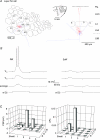
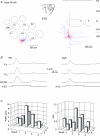


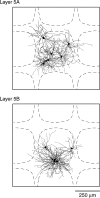







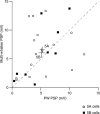
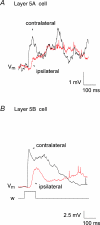
References
-
- Ahissar E, Sosnik R, Bagdasarian K, Haidarliu S. Temporal frequency of whisker movement. II. Laminar organization of cortical representations. J Neurophysiol. 2001;86:354–367. - PubMed
-
- Ahissar E, Sosnik R, Haidarliu S. Transformation from temporal to rate coding in a somatosensory thalamocortical pathway. Nature. 2000;406:302–306. - PubMed
-
- Anderson J, Lampl I, Reichova I, Carandini M, Ferster D. Stimulus dependence of two-state fluctuations of membrane potential in cat visual cortex. Nat Neurosci. 2000;3:617–621. - PubMed
-
- Armstrong-James M, Fox K. Spatiotemporal convergence and divergence in the rat S1 ‘barrel’ cortex. J Comp Neurol. 1987;263:265–281. - PubMed
-
- Armstrong-James M, Fox K, Das-Gupta A. Flow of excitation within rat barrel cortex on striking a single vibrissa. J Neurophysiol. 1992;68:1345–1358. - PubMed
Publication types
MeSH terms
LinkOut - more resources
Full Text Sources
Miscellaneous

